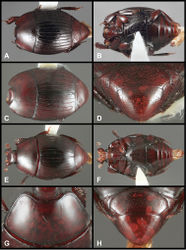Crenulister seriatus
| Notice: | This page is derived from the original publication listed below, whose author(s) should always be credited. Further contributors may edit and improve the content of this page and, consequently, need to be credited as well (see page history). Any assessment of factual correctness requires a careful review of the original article as well as of subsequent contributions.
If you are uncertain whether your planned contribution is correct or not, we suggest that you use the associated discussion page instead of editing the page directly. This page should be cited as follows (rationale):
Citation formats to copy and paste
BibTeX: @article{Caterino2014ZooKeys381, RIS/ Endnote: TY - JOUR Wikipedia/ Citizendium: <ref name="Caterino2014ZooKeys381">{{Citation See also the citation download page at the journal. |
Ordo: Coleoptera
Familia: Histeridae
Genus: Crenulister
Name
Crenulister seriatus Caterino & Tishechkin, 2014 sp. n. – Wikispecies link – ZooBank link – Pensoft Profile
Type locality
FRENCH GUIANA: Belvèdére de Saül [3.01°N, 53.21°W].
Type material
Holotype male: “GUYANE FRANÇAISE: Bélvédère de Saúl, point de vue. 3°1'22"N, 53°12'34"W. Piège vitre, 20.xii.2010. SEAG leg.” / “Caterino/Tishechkin Exosternini Voucher EXO-01768” (MNHN). Paratypes (5): 4: same locality as type, 7.i.2011, 24.i.2011, 31.i.2011, and 2.ix.2011 (CHND, FMNH, MSCC); 1: Régina, Réserve des Nouragues, 4°2.27'N, 52°40.35'W, 3.ix.2009, FIT, SEAG (CHND).
Diagnostic description
Length: 2.7–3.0 mm, width: 2.2–2.4 mm; as for generic description with the following diagnostic characters: body dark rufobrunneus, elongate oval, weakly convex; frontal stria fine, complete, frontal disk shallowly depressed, with few or no secondary punctures; epistoma with weak lateral ridges delimiting median depression bearing weak basal strioles; labrum about 4× wider than long, apical margin weakly outwardly arcuate; pronotum with gland opening track extending posterad behind middle, with 4 more or less evenly spaced openings; pronotal sides weakly depressed along smooth, raised lateral submarginal stria; pronotal disk with only a single series secondary punctures along basal margin, with a few encircling weak prescutellar impression, sides impunctate; elytron with one complete, crenulate epipleural stria and second, incomplete stria closer to margin in posterior half, inner subhumeral stria variably obsolete in about basal third, all other dorsal striae complete, moderately coarsely impressed, appearing chain-like; interstriae almost entirely lacking secondary punctures; prosternal keel with complete carinal striae slightly divergent anteriorly, not connected, faint secondary carinal stria present between carinal stria and procoxa; prosternal lobe deflexed in anterior half, with marginal stria present only at middle; mesoventrite with marginal stria weakly crenulate, mesometaventral stria crenulate, subangulately arched forward just beyond mesoventral midpoint; postmesocoxal stria slightly recurved anterad around mesocoxa, nearly reaching mesepimeron; lateral metaventral stria not crenulate, reaching inner third of metacoxa; metaventrite with secondary punctation largely uniform, but median punctures slightly smaller than those at sides; metepisternal punctures vaguely coalesced into a short stria; lateral stria of 1st abdominal ventrite well impressed along inner edge of metacoxa, with a separate transverse striole behind metacoxa; punctures of 1st abdominal ventrite limited to anterior third of median part of disk, with few oblique punctures posterad metacoxa; posterior margins of ventrites 1-4 very narrowly striatopunctate; protibia 7-8-spined, with marginal dentation weakly developed; mesotibia with 6-8 spines along margin, metatibia with fewer spines, present mainly along apical half; propygidium with secondary punctures quite small, sparse, separated by 2-4× their diameters, becoming obsolete in apical fourth; propygidial disk lacking anterolateral strioles; pygidium lacking secondary punctures; pygidial gland openings distinct about one-sixth from anterior margin, equidistant from lateral margin; pygidial margin lacking striae. Male (T8, S8, T9 as in Crenulister grossus; see Fig. 20): accessory sclerites absent; T8 with ventrolateral apodemes strongly narrowed beneath; S8 with halves meeting only at basal corner, inner margins short and strongly divergent, with about 7 strong setae toward apex; T9 with apices narrowly obliquely truncate; T10 desclerotized along much of midline, only undivided at middle; S9 short, broad, widened to weakly emarginate base, apex broadly emarginate (Fig. 21A); tegmen (Fig. 21B–C) with sides weakly rounded, widening to just beyond midpoint, narrowed to apex, apices slightly separated, medioventral process produced beneath about one-third from base; median lobe about one-third tegmen length, basal piece just over one-third tegmen length.
Remarks
This species is quite distinguishable by its relative lack of secondary punctures (Fig. 19E). Those of the pronotum occur only along the basal margin; those of the interstriae are essentially lacking; the 1st abdominal ventrite is punctate only in the anterior third; and the pygidium (Fig. 19H) is devoid of secondary punctures. Among the larger, darker species, these features readily diagnose it.
Etymology
This species’ name refers to its particularly conspicuous series of pronotal gland openings, against a largely impunctate background.
Original Description
- Caterino, M; Tishechkin, A; 2014: New genera and species of Neotropical Exosternini (Coleoptera, Histeridae) ZooKeys, 381: 11-78. doi
Images
|



